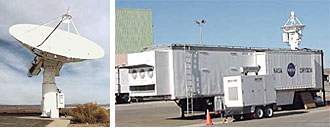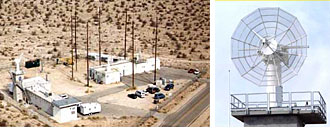- NASA Home
- | Centers
- | Dryden Home
- | Research
- | Facilities
- | WATR
Search Dryden
Test Systems
Western Aeronautical Test Range - WATR
WATR Telemetry
 Telemetry Antenna (left) and Mobile Operations Trailer (right)
Telemetry Antenna (left) and Mobile Operations Trailer (right)WATR telemetry tracking systems consist of multiple fixed antennas at Dryden and a fleet of mobile systems for deployment to specified locations. The antennas are capable of supporting down-linked telemetry and video signals in C-, L-, and S-bands while sending up-linked commands in either L- or S-bands. The antennas track targets from horizon to horizon and are certified as having full on-orbit capability for low earth orbiting spacecraft. Down-linked telemetry may be received in either analog or digital format. Mobile operations can provide telemetry tracking for test missions operating outside local airspace boundaries.
WATR Communications
 Radio Frequency Communications Facility (left) and RF Antenna (right)
Radio Frequency Communications Facility (left) and RF Antenna (right)The Radio Frequency (RF) Communications facility provides more than 40 ultra high frequency (UHF), very high frequency (VHF), and high frequency (HF) transmitter receivers, and a UHF flight termination system (FTS). An extensive range intercommunication system consists of trunk lines, communication panels, public address systems, commercial telephone systems, and military ground communication networks. An integrated network of communication, fiber optic, and satellite systems is also used to relay telemetry, radar, audio, and video data between Dryden facilities, NASA centers, other government agencies, and industry partners.
WATR Radar
 Instrumentation Radar
Instrumentation RadarTwo high accuracy C-band instrumentation radars provide Time Space Positioning Information (TSPI) of research aircraft and low earth orbiting spacecraft to the mission control center. Each radar can track targets out to a distance of 3,000 nautical miles with accuracies to 0.0006 degrees in angle and 30 feet in range. The radar antennas have the capability to accept acquisition data in various formats, record the data onsite, and provide post-flight radar data in engineering parameters. The WATR operates a Differential Global Positioning Satellite (DGPS) ground station that can up-link error corrections to research vehicles. Down-linked GPS embedded in the aircraft telemetry signal can provide positioning information to ground controllers. Federal Aviation Association (FAA) radar surveillance data is also available in the mission control center.
WATR Video
 Mobile Video Van (left) and Long Range Video Tracking Camera (right)
Mobile Video Van (left) and Long Range Video Tracking Camera (right)Numerous fixed and mobile camera systems acquire operational video data for flight monitoring, safety, and mission control. WATR video systems include a long-range broad-cast quality High Definition optical system providing day and night (infrared) coverage of local airspace. Other video systems provide coverage of the flight line, ramp areas, and runways. Mobile video vans are available for remote testing areas with real-time video provided to the mission control center via microwave links. Down-linked video from research vehicles or chase aircraft can be received in C-, L-, or S-band frequencies. Video recording is provided on VHS, Super VHS, Beta Superior Performance, DVD, or High Definition media.
WATR Mission Control Center
 Mission Control Center
Mission Control CenterThe Mission Control Center (MCC) is configured with up to 26 test engineering stations (with stripcharts), communications (radio and intercom) panels, video monitors, weather data, IRIG-B timing, and special graphics displays. Range control, mission control, test operations, range safety, and test director consoles provide critical analysis and display capabilities during real-time test missions. Data processing systems acquire and merge data from multiple sources in various formats to a single, time-correlated, composite stream for processing, distribution, real-time display, and storage archival. Segments of post-mission data is available on portable media immediately following the test mission.
WATR Mobile Operations
 Mobile Operations Trailer (left) and Mobile Video Van (right)
Mobile Operations Trailer (left) and Mobile Video Van (right)The WATR has a variety of mobile systems ready to be deployed to a specified location on very short notice. These systems provide Radio Frequency (RF) communication, video, and telemetry tracking support. The mobile operations system can process and display data onsite, or reformat data and transmit it to a customer’s facility. Mobile video vans provide coverage in remote areas and have the ability to relay video to the mission control center or other facilities via microwave links.
Related Links
+ WATR Fact Sheet
+ WATR Brochure
+ More WATR News